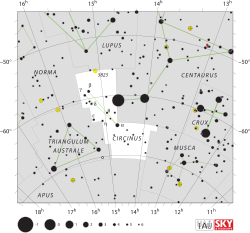Zeta Circini
| Zeta Circini | |
 | |
| Observationsdata Epok: J2000.0 | |
|---|---|
| Stjärnbild | Cirkelpassaren |
| Rektascension | 14t 54m 42,58159s[1] |
| Deklination | -65° 59′ 27,9460″[1] |
| Skenbar magnitud () | 6,08[2] |
| Stjärntyp | |
| Spektraltyp | B2/3 Vn[3] |
| U–B | -0,617[2] |
| B–V | -0,073[2] |
| Variabeltyp | Pulserande variabel av 53 Persei-typ (SPB)[4] |
| Astrometri | |
| Radialhastighet () | -18,0 ± 4,3[5] km/s |
| Egenrörelse (µ) | RA: -6,40[1] mas/år Dek.: -12,56[1] mas/år |
| Parallax () | 2,56 ± 0,36[1] |
| Avstånd | ca 1 300 lå (ca 390 pc) |
| Absolut magnitud () | -1,82[6] |
| Detaljer | |
| Massa | 5,5 ± 1,0[4] M☉ |
| Radie | 3,8 ± 1,3 [4] R☉ |
| Luminositet | 602[7] L☉ |
| Temperatur | 16 788[4] K |
| Vinkelhastighet | 264 ± 8[4] |
| Ålder | 31,6 ± 5,7[8] miljoner år |
| Andra beteckningar | |
| GCRV 8645, 2MASS J14544262-6559281, UBV 12944, CD-65 1813, GEN# +1.00131058, PPM 361077, UBV M 20410, CPC 21 3344, HD 131058, SAO 252951, uvby98 100131058, CPD-65 2918, HIC 72965, SKY# 27072, Gaia DR1 5848760569611424768, HIP 72965, TD1 17773, GC 20017, HR 5539, TYC 9032-2566-1[9] | |
Zeta Circini (ζ Circini, förkortat, Zeta Cir, ζ Cir), som är stjärnans Bayer-beteckning, är en ensam stjärna med en skenbar magnitud på 6,08[2] i Cirkelpassarens stjärnbild och är svagt synlig för blotta ögat där ljusföroreningar ej förekommer. Baserat på parallaxmätning inom Hipparcosuppdraget på ca 2,6[1] mas, beräknas den befinna sig på ett avstånd på ca 1 300 ljusår (ca 390 parsek) från solen.
Egenskaper
Zeta Circini är en blå till vit stjärna i huvudserien av spektralklass B2/3 Vn[3], där "n"-suffixet står för breda ("diffusa") absorptionslinjer i spektret på grund av stjärnans snabba rotation. Den har en massa som är ca 5,5[4] gånger större än solens massa, en radie som är ca 3,8[4] gånger större än solens och utsänder från dess fotosfär ca 600[7] gånger mera energi än solen vid en effektiv temperatur av ca 16 800[4] K.
Zeta Circini är en långsamt pulserande stjärna[4] med en frekvens av 0,26877 dygn och en amplitud av 0,0046 magnitud.[10] Den genomsnittliga kvadratiska fältstyrkan hos stjärnans longitudinella magnetfält är (1,06 ± 0,46) × 10-2 T.[11]
Referenser
- Den här artikeln är helt eller delvis baserad på material från engelskspråkiga Wikipedia, tidigare version.
Noter
- ^ [a b c d e f] van Leeuwen, F. (2007), "Validation of the new Hipparcos reduction", Astronomy and Astrophysics, 474 (2): 653–664, arXiv:0708.1752, Bibcode:2007A&A...474..653V, doi:10.1051/0004-6361:20078357.
- ^ [a b c d] Gutierrez-Moreno, Adelina; Moreno, Hugo (June 1968), "A photometric investigation of the Scorpio-Centaurus association", Astrophysical Journal Supplement, 15: 459, Bibcode:1968ApJS...15..459G, doi:10.1086/190168.
- ^ [a b] Houk, Nancy; Cowley, A. P. (1979), University of Michigan Catalogue of two-dimensional spectral types for the HD stars, 1, Ann Arbor, Michigan: Department of Astronomy, University of Michigan, Bibcode:1978mcts.book.....H.
- ^ [a b c d e f g h i] Hubrig, S.; Briquet, M.; Schöller, M.; De Cat, P.; Mathys, G.; Aerts, C. (June 2006), "Discovery of magnetic fields in the βCephei star ξ1 CMa and in several slowly pulsating B stars*", Monthly Notices of the Royal Astronomical Society: Letters, 369 (1): L61–L65, arXiv:astro-ph/0604283, Bibcode:2006MNRAS.369L..61H, doi:10.1111/j.1745-3933.2006.00175.x.
- ^ de Bruijne, J. H. J.; Eilers, A.-C. (October 2012), "Radial velocities for the HIPPARCOS-Gaia Hundred-Thousand-Proper-Motion project", Astronomy & Astrophysics, 546: 14, arXiv:1208.3048, Bibcode:2012A&A...546A..61D, doi:10.1051/0004-6361/201219219, A61.
- ^ Anderson, E.; Francis, Ch. (2012), "XHIP: An extended hipparcos compilation", Astronomy Letters, 38 (5): 331, arXiv:1108.4971, Bibcode:2012AstL...38..331A, doi:10.1134/S1063773712050015.
- ^ [a b] McDonald, I.; et al. (2012), "Fundamental Parameters and Infrared Excesses of Hipparcos Stars", Monthly Notices of the Royal Astronomical Society, 427 (1): 343–57, arXiv:1208.2037, Bibcode:2012MNRAS.427..343M, doi:10.1111/j.1365-2966.2012.21873.x.
- ^ Tetzlaff, N.; et al. (January 2011), "A catalogue of young runaway Hipparcos stars within 3 kpc from the Sun", Monthly Notices of the Royal Astronomical Society, 410 (1): 190–200, arXiv:1007.4883, Bibcode:2011MNRAS.410..190T, doi:10.1111/j.1365-2966.2010.17434.x.
- ^ ”Basic data: V* Zet Cir – Star” (på engelska). Centre de Données astronomiques de Strasbourg. http://simbad.u-strasbg.fr/simbad/sim-basic?Ident=Zet+Cir&submit=SIMBAD+search. Läst 22 januari 2018.
- ^ Koen, Chris; Eyer, Laurent (March 2002), "New periodic variables from the Hipparcos epoch photometry", Monthly Notices of the Royal Astronomical Society, 331 (1): 45–59, arXiv:astro-ph/0112194, Bibcode:2002MNRAS.331...45K, doi:10.1046/j.1365-8711.2002.05150.x.
- ^ Bychkov, V. D.; et al. (April 2009), "Catalogue of averaged stellar effective magnetic fields - II. Re-discussion of chemically peculiar A and B stars", Monthly Notices of the Royal Astronomical Society, 394 (3): 1338–1350, Bibcode:2009MNRAS.394.1338B, doi:10.1111/j.1365-2966.2008.14227.x.
Externa länkar
| ||||||||||||||||
Media som används på denna webbplats
Författare/Upphovsman: IAU and Sky & Telescope magazine (Roger Sinnott & Rick Fienberg), Licens: CC BY 3.0
IAU Circinus chart


